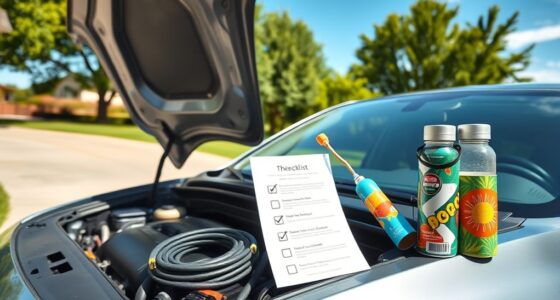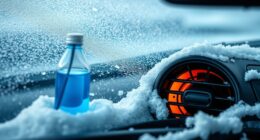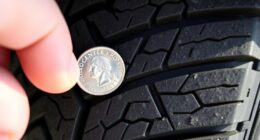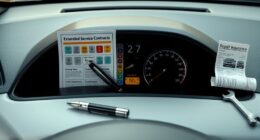To protect your car’s paint in the summer sun, regularly wash and wax it to shield against UV rays and environmental damage. Park in shaded areas or use a car cover whenever possible. Applying high-quality polish helps remove minor imperfections and restores shine, while protective coatings like wax or sealant create a barrier against fading and oxidation. For best results, stay proactive with upkeep—continue exploring ways to keep your car looking its best under the sun.
Key Takeaways
- Regularly wash and polish your car to remove dirt and oxidized paint layers caused by UV exposure.
- Apply a high-quality wax or sealant after polishing to create a protective barrier against UV rays.
- Park in shaded areas or use a car cover to minimize direct sun contact and reduce paint deterioration.
- Consider periodic paint polishing to smooth out imperfections and rejuvenate the glossy finish.
- Inspect your vehicle’s paint regularly and address any signs of UV damage promptly for easier maintenance.
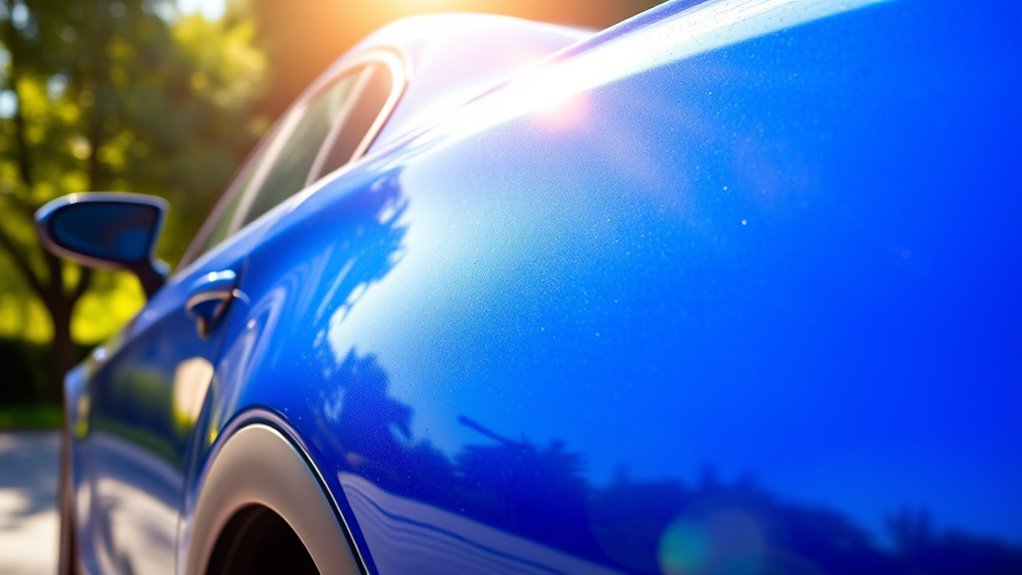
Ever wonder how to keep your car’s paint looking brand new? During the summer months, the sun’s intense rays can cause serious damage to your vehicle’s exterior. One of the biggest threats is UV damage, which breaks down the clear coat and paint layers over time, leading to fading, oxidation, and a dull appearance. To combat this, regular paint polishing becomes vital. Paint polishing smooths out minor imperfections and restores the glossy finish, but it also helps remove a thin layer of oxidized paint that has been compromised by UV exposure. By polishing your car periodically, you not only improve its appearance but also create a protective barrier against further UV harm.
The key is to start with a thorough wash, removing dirt and debris that can scratch the surface during polishing. Once clean, use a high-quality polish designed for automotive paint. This step helps to fill in small scratches and swirl marks caused by everyday wear, which are often exacerbated by the sun’s rays. As you polish, you remove the oxidized layer of paint that has been degraded by UV damage, revealing fresh, vibrant layers underneath. This process essentially rejuvenates your car’s paint, making it look newer and more polished. Keep in mind, over-polishing can strip too much paint, so it’s best to do this in moderation, especially if your car’s paint is already thin or aged. Proper maintenance can also include protective coatings that extend the lifespan of your paintwork.
Applying a good wax or sealant after polishing adds an extra layer of protection against UV rays and environmental contaminants. These products form a barrier that reflects harmful sunlight and prevents further oxidation. During the hot summer days, parking in shaded areas or using a car cover can also considerably reduce UV exposure. Remember, the sooner you address UV damage, the easier it is to maintain your car’s pristine appearance. Regularly inspecting your vehicle’s paint and performing paint polishing when needed keeps your car looking shiny and new, even under the relentless summer sun.
Frequently Asked Questions
How Often Should I Apply Wax During Summer?
You should apply wax every 2 to 3 months during summer to maintain ideal protection. Your wax frequency depends on your summer waxing schedule, considering exposure to sun, heat, and contaminants. Regular waxing helps shield your car’s paint from UV damage and environmental elements. If you notice the wax layer fading or your car’s shine diminishing, it’s time for a fresh layer. Stick to this schedule for lasting gloss and paint protection.
Can Parking in the Shade Prevent Paint Damage?
Parking in the shade can substantially reduce paint damage, as studies show shaded areas can lower temperatures by up to 20°F. Shade protection minimizes UV exposure and heat buildup, both of which accelerate paint fading and cracking. By choosing shaded parking spots, you benefit from decreased paint wear and prolonged car finish life. It’s a simple yet effective way to shield your car’s paint and maintain its appearance during hot summer days.
Are Ceramic Coatings Effective Against Summer UV Rays?
Yes, ceramic coatings are effective against summer UV rays. They provide excellent UV protection, shielding your car’s paint from harmful sun damage. Plus, their coating durability helps maintain that protection over time, even with frequent sun exposure. Applying a high-quality ceramic coating guarantees your car stays looking new longer, reducing fading and oxidation caused by UV rays. You’ll enjoy better paint preservation and increased peace of mind during those hot summer months.
What’s the Best Way to Remove Summer Bird Droppings?
Did you know bird droppings can damage your car’s paint in just a few hours? To remove bird droppings effectively, act quickly using gentle cleaning techniques. Start by soaking the droppings with water or a dedicated car cleaner to loosen them. Then, use a soft cloth or sponge to carefully wipe away residue, avoiding scrubbing to prevent scratches. Regularly cleaning techniques help preserve your car’s shine and prevent lasting damage.
Does Using a Car Cover Protect Paint From Heat?
Yes, using a car cover can protect your paint from heat. Look for one with UV protection and heat resistance, as these features help prevent sun damage and reduce interior temperatures. A good cover shields your vehicle from direct sunlight, lowering the risk of paint fading, cracking, or peeling. It also keeps the surface cooler, minimizing thermal stress and preserving your car’s paint in the hot summer months.
Conclusion
By taking simple steps like washing regularly and applying a good wax, you protect your car’s paint from summer sun damage. Imagine John, who neglected his car’s shine last summer and ended up with stubborn fading and scratches. Don’t let that be you. Stay proactive by shielding your car’s paint now, and enjoy a glossy finish all season long. Your car will thank you with a vibrant look, no matter how hot it gets outside.



